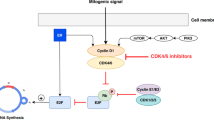Summary
The initial metabolism of ifosfamide (IF) consists of two different pathways: enzymatic hydroxylation at carbon-4 forms the cytostatically active metabolite 4-OH-IF (“activated ifosfamide”) whereas side-chain oxidation results in the liberation of chloroacetaldehyde, a compound with possible neurotoxic properties. The pharmacokinetics of ifosfamide and its activated form were investigated in 12 cancer patients, who received both oral and i.v. treatment in a randomized sequence on days 1 and 3 at a dose of 1 g/m2 (n=7) or 1.5 g/m2 (n=5). In 3 patients the pharmacokinetics of chloroacetaldehyde were also investigated. After oral application, ifosfamide absorption proceeded rapidly, the oral bioavailability was 0.92. Independent of the route of ifosfamide application on day 1, the terminal half-life on day 3 (when the drug was given by the alternative route) was decreased in 6 out of the 12 patients, thus indicating self-induction of hepatic metabolism. 4-OH-IF was already present 20 min after ifosfamide administration. In the individual patient the concentrations of 4-OH-IF were always higher after oral than after i.v. IF application: the mean p.o.:i.v. ratios forc max and the area under the concentration/time curve were 2.3 and 1.7 respectively (P<0.05). In a first series of 3 patients the chloroacetaldehyde concentrations measured after oral ifosfamide application were about twice as high as those when the drug was given intravenously. These results indicate that (in comparison to the i.v. route) orally administered ifosfamide may be more cancerotoxic but also leads to higher levels of chloroacetaldehyde. This would explain the neurotoxic sideeffects previously seen after oral administration of comparatively low ifosfamide doses.
Similar content being viewed by others
Abbreviations
- 4-OH-IF:
-
4-hydroxyifosfamide (activated ifosfamide)
- 4-OH-CP:
-
4-hydroxycyclophosphamide (activated cyclophosphamide)
- 7-OH-QU:
-
7-hydroxy-quinoline
- AUC:
-
area under thec/t curve
References
Alarcon RA (1968) Fluorometric determination of acrolein and related compounds withm-aminophenol. Anal Chem 40:1704–1708
Arndt AS, Balis FM, McCully CL, Colvin OM, Poplack DG (1988) Cerebrospinal fluid penetration of active metabolites of cyclophosphamide and ifosfamide in rhesus monkeys. Cancer Res 48:2113–2115
Brade WP, Herdrich K, Varini M (1985) Ifosfamide — pharmacology, safety and therapeutic potential. Cancer Treat Rev 12:1–47
Cerny T, Margison JM, Thatcher N, Wilkinson PM (1986) Bioavailability of ifosfamide in patients with bronchial carcinoma. Cancer Chemother Pharmacol 18:261–264
Farmer PB (1988) Enantiomers of cyclophosphamide and iphosphamide. Biochem Pharmacol 37:145–148
Goren MP, Wright RK, Pratt CB, Pell FE (1986) Dechlorethylation of ifosfamide and neurotoxicity. Lancet 2:1219–1220
Klein HO, Wickramanayake PD, Christian E, Coerper C (1984) Therapeutic effects of single-push or fractionated injections or continuous infusion of oxazaphosphorines (cyclophosphamide, ifosfamide, ASTA Z 7557). Cancer 54:1193–1203
Küpfer A, Cerny T, Idle JR (1990) Intramolecular rearrangement of ifosfamide in aqueous solutions. Lancet 1:1461
Lind MJ, Margison JM, Cerny T, Thatcher N, Wilkinson PM (1989) Comparative pharmacokinetics and alkylating activity of fractionated intravenous and oral ifosfamide in patients with bronchogenic carcinoma. Cancer Res 49:753–757
Morgan LR, Harrison EF, Hawke JE, Hunter HL, Costanzi JJ, Plotkin D, Tucker WG, Worall PM (1982) Toxicity of single — vs fractionated — dose ifosfamide in non small cell lung cancer: a multi-center study. Semin Oncol 9 [Suppl l]:66–70
Nelson RL, Allen LM, Creaven PJ (1976) Pharmacokinetics of divided dose ifosfamide. Clin Pharmacol Ther 19:365–370
Norpoth K (1976) Studies on the metabolism of isophosphamide (NSC 109724) in man. Cancer Treat Rep 60:437–443
Piazza E, Cattaneo MT, Varini M (1984) Pharmacokinetic studies in lung cancer patients. Cancer 54:1187–1192
Schuler U, Ehninger G, Wagner T (1987) Repeated high-dose cyclophosphamide administration in bone marrow transplantation: exposure to activated metabolites. Cancer Chemother Pharmacol 20:248–252
Sladek NE (1973) Bioassay and relative cytotoxic potency of cyclophosphamide metabolites generated in vitro and in vivo. Cancer Res 33:1150–1158
Sladek NE (1988) Metabolism of oxazaphosphorines. Pharmacol Ther 37:301–355
Sladek NE, Doeden D, Powers JF, Krivit W (1984) Plasma concentrations of 4-hydroxy-cyclophosphamide and phosphoramide mustard in patients repeatedly given high doses of cyclophosphamide in preparation for bone marrow transplantation. Cancer Treat Rep 68:1247–1254
Wagner T, Drings P, (1986) Pharmakokinetics and bioavailability of oral ifosfamide. Arzneimittelforschung (Drug Res) 36:878–880
Wagner T, Fenneberg K (1984) Pharmacokinetics and bioavailability of cyclophosphamide from oral formulations. Arzneimittelforschung (Drug Res) 34:313–316
Wagner T, Peter G, Voelcker G, Hohorst HJ (1977) Characterization and quantitative estimation of activated cyclophosphamide in blood and urine. Cancer Res 37:2592–2596
Wagner T, Heydrich D, Jork T, Voelcker G, Hohorst HJ (1981) Comparative study on human pharmacokinetics of activated ifosfamide and cyclophosphamide by a modified fluorometric test. J Cancer Res Clin Oncol 100:95–104
Author information
Authors and Affiliations
Rights and permissions
About this article
Cite this article
Kurowski, V., Cerny, T., Küpfer, A. et al. Metabolism and pharmacokinetics of oral and intravenous ifosfamide. J Cancer Res Clin Oncol 117 (Suppl 4), S148–S153 (1991). https://doi.org/10.1007/BF01613221
Issue Date:
DOI: https://doi.org/10.1007/BF01613221




